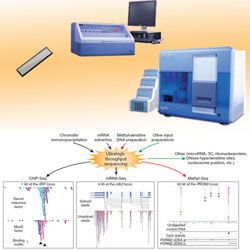Difference between revisions of "Sequencing"
| Line 7: | Line 7: | ||
}} | }} | ||
| − | GTC | + | GTC offers sequencing services using 2 highthroughput sequencing platforms: |
| − | + | * Illumina Genome Analyzers II | |
| + | * HiSeq 2000 | ||
= Sample Submission Guidelines = | = Sample Submission Guidelines = | ||
Revision as of 10:46, 28 December 2010
|
GTC offers sequencing services using 2 highthroughput sequencing platforms:
- Illumina Genome Analyzers II
- HiSeq 2000
Contents
Sample Submission Guidelines
Users are required to prepare their own sequencing libraries. Samples should be gel-purified and provided UNDILUTED in EB.
Users should submit 5uL of undiluted sample. We will determine the concentration by RT-PCR and make the appropriate dilutions. Excess sample will be retained in our freezers for potential future re-run. Users are also strongly encouraged to retain a portion of their samples in case of emergency.
GTC will provide sequencing primers for libraries prepared with standard Illumina adapters. If custom sequencing primers are required they must be provided at the time of sample submission.
Data
Images acquired from the solexa sequencer are processed through the bundled solexa inage extraction pipeline to get the sequence and quality score for each base. The data is aligned to a reference genome, if requested, using an interative ELAND algorithm. An in-depth QC report is included in the package.
Protocols
Please refer to the protocols section here - Protocols
Turnaround Time
Each Genome Analyzer processes 8 samples per run, or 7 samples plus a control. Full flowcells can be run usually within two weeks of submission. Partial submissions of less than eight samples (or 7 with control) are put into a project queue, where they join existing samples or await others before processing. Wait times for partial submissions vary but are generally two weeks or less, depending on demand from other users.
Applications
ChIP-Seq
ChIP-Sequencing (or ChIP-Seq) combines chromatin immunoprecipitation (ChIP) with DNA sequencing allowing researchers to identify the binding sites of DNA-associated proteins.
Small RNA Sequencing
Small RNA discovery provides identification of non-coding RNA to aid in the understanding of gene regulation. It can be helpful in identifying novel small RNA molecules. http://illumina.com/downloads/rnaDGESmallRNA_Datasheet.pdf
mRNA Sequencing
We offer a mRNA Sequencing service utilizing the Genome Analyzer System (Solexa) from Illumina. Primarily, we offer:
- Digital Gene Expression Sequencing Service
Digital Gene Expression is similar to SAGE analysis. Sequencing of short mRNA “tags” provides genome-wide expression profiles and is used as an alternative to full-genome microarray hybridization or qPCR. Digital Gene Expression is more sensitive and has a greater dynamic range than traditional microarrays allowing for more accurate quantification and detection of very low abundance transcripts. http://illumina.com/downloads/rnaDGETagProfiling.pdf
- Whole Transcriptome Analysis
Sequencing the entire transcriptome can reveal valuable information about exon boundaries and splice variants that may be missed by microarray analysis or Digital Gene Expression. Kits for whole transcriptome analysis are expected to be available from Illumina soon.
Denovo Sequencing
De novo sequencing can be done using the Genome Analyzer, although the short read lengths can make assembly challenging, especially in larger genomes. However, advancements are being made to increase read length and improve assembly algorithms. http://illumina.com/downloads/ch2-ILMN_ProdGuide_DNAsequencing.pdf
